Kissing Books: Assertive contact
Every month, Olivia Waite pulls back the covers, revealing the very best in new, and classic, romance. We're extending a hand to you. Won't you take it? And if you're still not sated, there's always the archives.
In the sleek modern lobby of the HarperCollins offices in Manhattan is a Chandler & Price letterpress from 1905. The metal is dark and lustrous, the wood gleams; it’s that kind of historical artifact whose heavy presence seems appropriate to its significance. I like it because I love letterpress, which shows us that printed books are the result of applied geography.
To print text in a press, you need to bring paper, ink, and metal type into assertive contact. There’s a moment where those three elements occupy the same geographic space—when the metal forces ink into the fibers of linen or pulp—and that’s the moment that creates something new: a handbill, an illuminated poem, a part of a novel. It is so tempting to think of stories as nebulous mind-things, ethereal dream-pictures as fluid and untouchable as thought.
But thoughts escape us. Texts remain.
Even in modern printing, which these days is largely digital, it’s useful to trace the geographical movements. Manuscripts written by authors are sent to New York for acquisition and editing, sent out to presses for printing (with paper largely from China and Canada), collected in warehouses, then shipped to bookstores where finished volumes pause briefly on store shelves before coming to rest on the tottering nightstand stacks of hopeful readers. Or, if the books don’t catch a reader’s eye, being sent back to be remaindered or pulped and turned into other, less refined volumes further down the recycling chain.
In this field of movement, New York sits on the history of American publishing like the proverbial bowling ball on the rubber sheet. If you’re not working with it, you’re working around it, and you’ll still be affected by how it shapes the gravity of the industry. For a century and longer, hopeful young writers and editors moved to New York to try and get closer to the great, beating heart of the whole system. The history of American writing is layered over and within New York’s physical geography. For example, I am writing this two blocks away from the Algonquin Round Table—though sadly not with a properly Parkeresque martini to hand.
Amazon is a second, newer bowling ball, growing heavier and heavier with every acquisition and upsetting the once-predictable path of everyone’s orbit. (Well, semi-predictable. For a given value of predictable. Publishing is very, very weird.)
Amazon specifically breaks the book world’s established geographic chain: in the corporation’s earliest incarnation, it was mostly there to facilitate the movement of books directly to the customer, no matter where book or customer was located. Until the company got a market toehold. Now, as its domain grows every more Lovecraftian—horrifically vast, inhuman, tentacles *everywhere*—it has brought down huge chain bookstores, and is reaching out into other industries to similarly turn them into fiefdoms (movies, groceries, and fashion, to name just a few).
It’s a fact that cracking the gatekept New York pipeline made possible opportunities for people the book world has long left behind: Black and brown genre writers, queer writers, disabled writers, people who can’t afford New York’s cost of living. That in addition to tastes and trends that publishing can never perfectly anticipate, and which in earlier decades might never have had a chance to reach readers. Amazon was right to make self-publishing easy and accessible. We get to hear a lot more voices now than we did before.
Amazon did not do this as a favor, or because it was right. Amazon did this for money, and power, and the company’s attack on geography is continuing. It will not be satisfied with New York. Amazon fought not to pay sales tax, demanded customer information from public libraries in exchange for Kindle loans, turned South Lake Union into a gentrified faux-place, demurred to support Seattle-based charities, overloaded public transit routes, sent neighborhood rents skyrocketing, and runs a network of warehouses that are horribly both Orwellian and Dickensian.
Even the vaunted self-publishing revolution comes with squicky parts. Scammers are gaming bestseller lists with boxed sets and ghostwriters and paid reviews, bots are offering absurd algorithm-generated prices for hard-to-find texts, and getting plagiarists and unlicensed copies of your work taken down is a fiendish stall the likes of which not even Kafka could dream up.
When you list it all out like that, it starts to look pretty evil.
It’s high time geography got a little of its own back.
This month, I’m asking you to find time to support local businesses, bookstores, libraries, and presses. Pick a title from the current IndieBound list, or use the site to find a bookstore near where you live. You can find indie bookstores that are romance-friendly on this crowdsourced map. August 17 is also Bookstore Romance Day, a day when indie bookstores and romance authors come together for mutual squee and swooning.
This month’s books are heavy on the geography theme: we have a couple of urban planners, rival dating site executives, a couple escaping family troubles by touring Cape Town, two women falling in love below stairs, and a Regency romance with a castaway cannibal hero (yes, you read that right). Geography may be destiny, as the historians say—but we all know destiny is no match for true love.
Recent Romances:
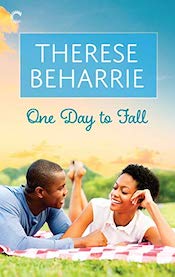
One Day to Fall by Therese Beharrie (Carina Press: contemporary m/f):
Category romances have long prided themselves on transporting readers to glamorous, vivid, and memorable locales—Greek-set romances are their own subgenre at this point (I really should look into who’s been studying those academically!)—and I’m hoping this tradition makes it ever easier to expand English-language romance settings beyond the US and UK. Certainly certified Rising Star Therese Beharrie is making a strong showing of doing just that, writing South African characters with local expertise and sensitivity. It’s not a tourist’s perspective, even when her lovers are dodging difficult family moments by visiting tourist sites. The reader gets the sense not just of having visited Cape Town, but of what it feels like to live there.
One Day to Fall does precisely what it promises: two strangers escaping from families in crisis resolve emotional issues and fall in love during the course of a single day. Beharrie’s books are dialogue-rich and in-depth about her characters’ baggage. The humor sucks you in and then oh no, there are so many feelings! We learn so much about how Angie and Parker think and feel, and how they’ve come to think and feel that way, that it never feels forced or rushed when they decide at the end of that single day that they’d like to try being a couple. Sure, it’s only been twenty-four hours, but we have more than enough information to know how they’ll cope with a shared future. Building that kind of depth in the swift, sleek category form is just—woof, I have no idea how Beharrie does it, but let’s let her keep doing it as often as she wants.
She frowned. Had his eyes always been that colour? A deep brown that contrasted the lighter brown of his skin? And had he always looked so young? There wasn’t a line on his face; nothing giving away that he was her age or older. She was only twenty-six, but there were lines on her face. Perhaps the gods had seen into her soul and identified her as the raggedy old bitch she was.
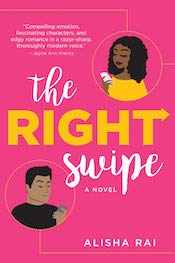
The Right Swipe by Alisha Rai (Avon Books: contemporary m/f):
There’s a strain of romcom shenanigans that delights in extensively mortifying a perfectly ordinary heroine. You’ll find none of that nonsense here.
You will find the heightened reality and tropey goodness you’re hoping for. There’s no real road map for smart choices when you end up fake-dating your one-night stand so your rival online dating sites can milk the publicity. Heroine Rhiannon is smart and ambitious and makes a lot of very understandable mistakes: she clings to her trauma coping mechanisms, she is prickly and suspicious, she has real baggage imperfectly wrestled with at the start of the story. But the narrative is not interested in punishing her for these faults, the way some romcoms might be (looking at you, Bridget Jones).
Rhiannon is one of Rai’s signature heroines: a mix of banter and broken edges, always human and relatable and deeply, deeply loveable. The quintessential best friend, the one you root for even when she’s kind of fucking it up.
Our hero, strong, steady former pro football player Samson, has plenty of wounds of his own—deep losses that still hurt and that call him to prevent other people from suffering in similar ways (family members lost to CTE and ALS). It’s a brilliant contrast with Rhiannon in so many ways: she was attacked by someone she loved and trusted who proved predatory, while Samson has had one loved one after another taken from him by accident and illness. Both characters wade into the waters of grief, but they’re approaching it from different sides of the river. It’s an extraordinary, subtle fountain of conflict that is almost more than the romance can bear.
Almost being the important word. As with Rai’s fiercely tender Forbidden Hearts series, so many of this book’s characters are all trying to take care of one another as best they can: a listening ear, a grounded focus to stem a rising panic attack, thoughtful advice and support at the lowest moments. Rai crafts a space of kindness and acceptance to offset an often vicious world: her protagonists don’t have to change their essential nature, they only are pushed to find better ways of being in the world. There’s a sharp meta edge to the story, an awareness of the way our culture frames romance and the ways in which that either buoys or fails us. There’s an extended dialogue on the definition of fuckboy that alone is probably worth the price of the book.
“Find me the empty soul who doesn’t get emotional over While You Were Sleeping.”
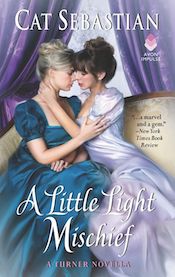
A Little Light Mischief by Cat Sebastian (Avon Impulse: historical f/f):
Back in January I predicted that 2019 was going to be a banner year for sapphic romance, and I have never been more delighted (and, let’s be honest, a little smug) to be proven right. Avon released their first f/f romance by Alyssa Cole (and then their first f/f historical, by me!), Courtney Milan’s elderly lesbians gloriously burned everything down, Berkley announced they’ll be publishing a contemporary f/f in 2020, and Rose Lerner just revealed the cover for her upcoming f/f Gothic The Sea May Burn.
And of course, this new perfect miniature gem from Cat Sebastian, loosely connected to her Turner series.
A Little Light Mischief may be the most aptly titled novella I have ever read: if it were any fluffier, it would float right off my tablet and into the ether. You could devour the whole thing in one gulp during a night of anxious insomnia (ask me how I know!). The prose-to-profanity ratio, though, is gratifyingly high for such a short book: we are dealing with working characters in the Regency, women with calloused hands and frank vocabularies and few scruples when it comes to putting food on the table.
Molly is a buxom self-described lightskirt and erstwhile thief, and I adored her. Alice is a shaken, self-effacing vicar’s daughter who was thrown into the street when her father blamed her for being assaulted by his benefactor’s horrible nephew. Both Alice and Molly are working for the wealthy Mrs. Wraxhall, whose eccentricities include being kind to her servants and not caring too much about their checkered pasts. Cat Sebastian couples are almost always a study in contrasts, and this story holds true to the tradition: Molly’s flexible morals and open lustiness hides a heart more tender than she lets on, and Alice’s shy, pale exterior and grey gowns are supported by a spine made of pure, tempered steel. The plot is better enjoyed than described, and the prose flowed so sweetly and beautifully along that at the end I was still hungry for more — this is more the amuse-bouche for a full-length novel than a meal unto itself. It’ll have to hold us until October and the next book, and I‘m left feeling shamefully greedy and impatient until then.
Alice was momentarily taken aback. Justice was in the same category as diamonds and gold—utterly unavailable to her, and therefore not worth thinking about. She was rather surprised that Mrs. Wraxhall still believed in it. But then again, people clung to stupid ideas long past the point of reason. She glanced at the parcel in her hands. Hope was one of them.
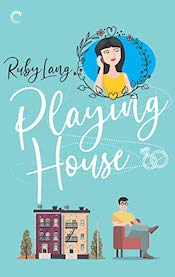
Playing House by Ruby Lang (contemporary m/f):
My dad was a real estate appraiser by trade, back when that was an independent profession and not something you were supposed to take on faith from the same big realtors who were selling you the home they fixed the value of (I have Opinions about real estate that go way back). He’d married into my mom’s family, who are handy in a way that goes beyond basic home maintenance and into things like construction, remodeling, and parts manufacture. The plot of land on a backwoods lake purchased by my great-grandfather was intended as a camping spot but too many of us got interested in improving it as a side hobby—it started with a concrete foundation, then a one-story house, then a two-story house, with wraparound deck, then a dock and beach, then a landscaped garden.
All of this is just to say that I am definitely the target audience for this thoughtful, grounded novella about two urban planners seducing one another by describing historic architecture, apartment design, and city development. It’s a lot of nerdery for a short book, but it goes a long way toward showing us our main couple’s shared passion and suitability. If you’re the kind of person who cruises apartment listings for fun even when you have no plans to move, this will be your kind of catnip.
Oliver Huang and Fay Liu are both career-focused, but in distinctly different ways. They tumble into the romcom situation of posing as a couple to tour high-end homes just for the fun of it, but the real conflict is about where they’re headed in life and what kind of partner they need for the journey. Fay is fresh off a divorce from a man who couldn’t keep up with her ambition and resented her for it; Oliver has been out of a job for a few months and is worried that the freelance life makes him too much like his feckless, absent father. They’ve known each other for a while but not well, and it’s pure pleasure watching them fall headlong as they deal with family stress, future plans, and a possible working relationship. The sex scenes feel juicy and lush but in a very modern way, like the kind of fashionable hand-knotted floral-patterned rug they sell for too much money at Anthropologie: somehow both cutting-edge and comforting at once. The main couple is just plain likeable, even when they’re bogged down in their issues, and the book builds to one of the best last lines I’ve seen in romance in a while. Count me in for this and for book two, the teaser for which gives us a hilarious peek into how our couple’s ruse really appeared to one of the realtors they were fooling.
He sank down into the couch with his eyes closed. “In love again?” Oliver asked.
“Of course. The boy of my dreams. He’s got dimples. And a cleft chin. He’s just bulges and depressions in all the right places.”
“Is he a man or is he a topographical map?”
“He’s the valleys and the mountains, and I’m going on a long hike along the trails—all the trails, baby.”
This Month’s Beach Book Featuring A Castaway Cannibal Hero and Yes You Read That Right
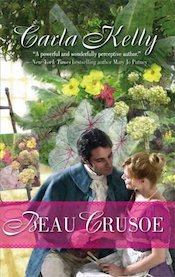
Beau Crusoe by Carla Kelly (Harlequin Books: historical m/f):
Oceans of ink have been spilled trying to define the elusive concept of a “beach book.” I prefer to define it as something you get along with a “beach body,” as in: do you have a body? Do you have a book? Great! Let’s go to the beach!
Summer reading should be all about stretching out, catching up, sinking in to something you might not have time for during the rest of the working year. If you want to sprawl in a lounge chair with Sandman or Melville or, famously, a doorstop biography of America’s first treasury secretary, that’s just fine. Ditto for pure escapist fluff, too, because life is hard and death comes quick and you deserve some time for just feeling good things about made-up people. And if you’re looking for a uniquely charming Regency, with long stretches of tropical golden sand, dramatic shipwrecks and rescues, a sweet romance between a castaway sailor and a botanical illustrator, and some gorgeously creepy scenes about having to eat other people in order to stave off starvation, then have I got the book for you!
Beau Crusoe is hands-down one of the strangest historical romances I have ever read. It sticks to the ribs of the mind. Many angsty historical heroes have backstories of abuse, betrayal, or wartime injury—but this book’s hero James Trevenen is angsty because he knows what people taste like and he has trouble forgetting it when he’s, say, sitting down to a meal with a bunch of well-fed aristocrats. It’s like Jane Austen’s Snowpiercer, full of surreally tinted dining scenes and night terrors and visitations from the ghosts of devoured sailors past. Also toucans in the foyer, the benefits and risks of civilization, and a sincerely adorable plot moppet. It’s sweet and strange and un-put-downable—in short, a perfect book for the long, hot days of summer.